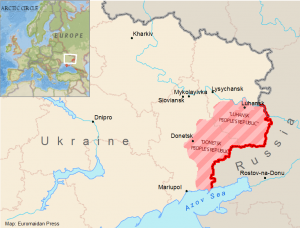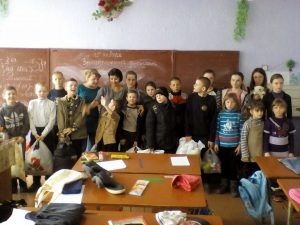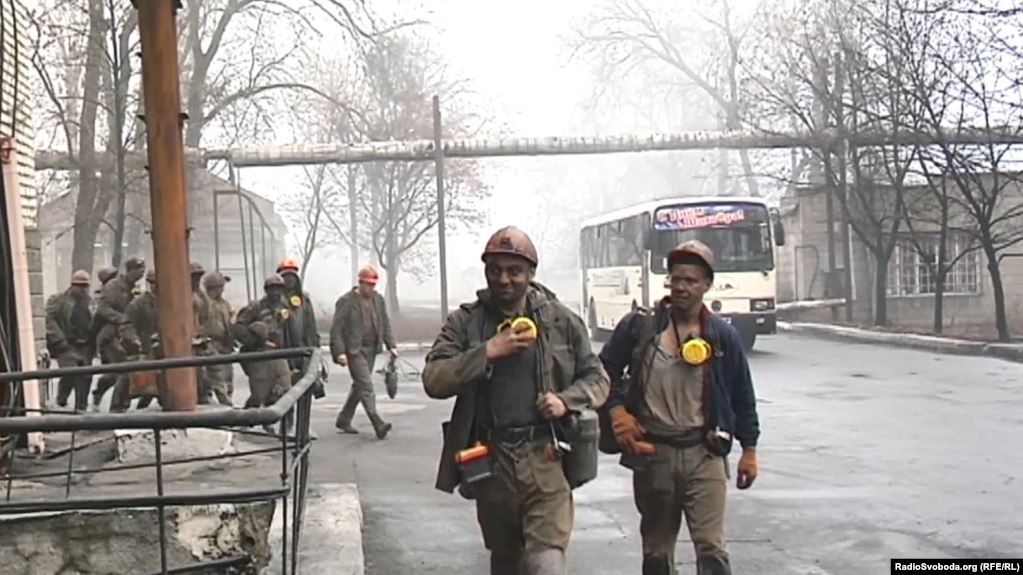Despite the intended all-for-all exchange of prisoners negotiated last fall by the Ukrainian and Russian presidents in Paris and two successful prisoner swaps that followed, the Russian occupation authorities of Ukraine's Donbas region keep holding many Ukrainians in illegal captivity, being sentenced in kangaroo courts after sham trials.
 The Ukrainian Media Initiative Group for Human Rights (MIHR) which deals with human rights abuse cases in occupied Donbas, has gathered their stories.
The Ukrainian Media Initiative Group for Human Rights (MIHR) which deals with human rights abuse cases in occupied Donbas, has gathered their stories.
Safety engineer who volunteered to help local orphans accused of spying

Liudmyla Huseinova (Parkhomenko) lives in occupied Novoazovsk on the Azov seaside town near the Russian border in Donetsk Oblast. She was abducted on 16 October 2019.
Liudmyla’s goddaughter Tetiana Huseinova told that her godmother worked as a safety engineer at a local poultry farm. The armed men came for her to her working place to bring her home for an illegal search where they confiscated all phones, laptops, flash drives, and took her away.
Liudmyla Huseinova's relatives learned about her abduction from the farm's manager who tried to help find his colleague, but to no avail. Huseinova's husband urgently returned from his migrant work but he also failed to find his wife. For two long months, Huseinova’s family remained in the dark about her whereabouts until they learned about her transfer to a pre-trial detention center and espionage charges.
As it turned out, Ms. Huseinova spent two months in the infamous Izoliatsia, the former art center on the premises of an insulation materials plant in Donetsk seized by the occupation forces in 2014 to be transformed into what some of its former prisoners describe as a concentration camp.
Read also: Donetsk art center turned into concentration camp: former hostages share their memories

Several times a month, Liudmyla visited the government-controlled city of Mariupol to collect the donations and bring them to the school situated in the frontline village of Prymorske, near Mariupol's eastern suburbs, The numerous photo reports of her trips are still available on her Facebook profile.
“Liuda [a diminutive of Liudmyla, - Ed.] asked to sign greeting cards for the wards, writing them the words of support. Some of the letters were written in Ukrainian,” said Huseinova's godchild Tetiana.
Ms. Huseinova openly shared pro-Ukrainian Facebook posts and didn't try to conceal the fact that she was living in the occupied town of Novoazovsk. This could be a sufficient reason for the occupation authorities to lock up the woman who committed no crime.
Youngsters accused of being bombers

Bohdan Kovalchuk didn't even turn 18 when he was abducted on 31 August 2016 with five other youngsters from Yasynuvata, a suburb of the regional center of Donetsk, to be accused later of bomb attacks.
The "DNR investigators" claimed that the young people collaborated with the SBU, the Ukrainian Security Service, and organized bomb attacks on cars and even a "police” station. And Bohdan, they claimed, was one of the group leaders.
"Kovalchuk put together a real gang, they lived by the laws of the wolf pack, so those who tried to bale out were threatened physical violence by their handler," Russian NTV channel told its audience.
Despite Ukraine's demands to release the teenagers, the occupation authorities' kangaroo court sentenced them to ten to fifteen years behind bars. Bohdan is now 21 and he remains captive for almost four years now.
Before the mass exchange of 29 December 2019, the young people and their parents were offered a "pardon" if they were going to stay in the occupied area instead of moving to government-controlled territories. All but Bohdan Kovalchuk accepted the deal. Bohdan insisted on being swapped because he wanted to live freely rather than closely watched and without the right to leave occupied Donbas, according to his companions in adversity.
Daria Morozova, the so-called "DNR Commissioner for Human Rights," promised to release Kovalchuk at the next exchange in three months. But on 16 April, when twenty captives returned to Ukraine, Bohdan wasn't among them. Moreover, the occupation authorities now deny that they keep him in their captivity despite the fact that he has been serving his "DNR court sentence" in the Torez penal colony among the non-political prisoners.
Bohdan's grandmother, Tetiana Piatnytsia, is currently waiting for him in the free Ukrainian territory. She says that before his arrest, her grandson was going to move in with her and study to become a car mechanic. He collected the full package of documents required to enter the teaching facility except for a medical certificate, so he had to go to Yasynuvata to get it. As he got there, Bohdan’s grandma lost track of him and two weeks later, the “DNR” released a video of the young men’s "confessions."
Only Kovalchuk's mother living in occupied Donbas had an opportunity to visit Bohdan in prison, yet with the COVID-19 lockdown, all visits were canceled and she lost touch with him.
A56-year-old “spy” in the Russian military HQ

Olena Fedoruk lived in the occupied Donetsk town of Kalmiuske known as Komsomolske prior to the 2016 decommunization. Illegal armed formations took her hostage on 25 July 2017, as uniform-clad people captured her in the center of her town and took her in an unknown direction to later charge her with espionage.
According to Ms. Fedoruk's daughter Yulia Savko who lives in Kyiv, her mother refused to leave her occupied hometown to support Ms. Savko's 82-year-old grandmother. Yulia says at the beginning of the occupation her mother struggled to keep her flower business running but soon had to seek a new job as her hometown became a restricted access settlement.
And Ms. Fedoruk became a household manager in the local military headquarters, accepting a job offered by her acquaintance.
Now Olena Fedoruk is kept in the female penal colony of the town of Snizhne, following her 11-year sentence pronounced by a sham court on 16 August 2019.
"All the women work hard in the colony," says Olena Lazareva, a former hostage that was formerly held there, "...some of them in the kitchen carrying heavy sacks of potatoes, removing garbage. But most are involved in the garment production ten hours a day with short breaks, during which it is even impossible to eat an apple or drink tea. And what makes it even more difficult is the fact that there are no people detained under political charges around you, only the so-called criminal ones.”
According to the "DNR investigators," Fedoruk acted not alone but in cahoots with a local resident Peter Sandulov, abducted two weeks before her. Unlike Fedoruk, he did not agree with the "court sentence" and filed an appeal to the occupation authorities, which might have been the reason for the exclusion of Ms. Fedoruk from the 29 December 2019 exchange list. Alternatively, the occupation authorities may see the woman who worked in the military HQ as a valuable informer for Ukraine and a potential witness against Russia in international trials.
A driver who helped people cross the contact line accused of collaboration with the SBU

People in military uniform detained Luhansk driver Yuriy Merzlyi at 3:00 a.m. on 22 March 2018 at a checkpoint, as he was driving with his wife and son. This was followed by searching his home and accusations of collaborating with the SBU.
According to Merzlyi's released inmates, Yuri was aware that he risked being detained because he often left the occupied territories, but transporting people across the contact line was a major source of income for his family to make ends meet. Shortly before his abduction, diabetic Yuri Merzlyi underwent surgery to remove a tumor.
He spent the first fifteen days if his illegal imprisonment in the basement of the so-called Ministry of State Security (MGB) in Luhansk, and was later transferred to a pre-trial detention center.
The "prosecutors" theorized that Merzlyi was "recruited by the SBU in [the Ukraine-controlled city of] Lysychansk" and he'd have "carried out intelligence activities" on the territory of the so-called Luhansk People's Republic (LNR), passing the information on local "law enforcement agencies."
After the unlawful verdict, Merzlyi's relatives submitted his name to Ukraine's exchange list, however, he has not yet been released. The occupation authorities do not confirm the fact of his detention, although it is known that Yuriy is currently kept in the Krasnyi Luch penál colony #19.
Meanwhile, as head of the presidential office Andriy Yermak noted, the prisoner exchange process has now been stalled after a few successful swaps last year and earlier this year.
Read also:
- Donetsk art center turned into concentration camp: former hostages share their memories
- “Russians taught how to torture.” Ex-captives of Donbas “republics” share horrors of basement prisons
- BBC: How the “DNR” special services & troll factory scare Russians with terror attacks
- Prisoner exchange between Ukraine and Russian occupation authorities in Donbas underway – PHOTOS
- Ukraine swaps 127 prisoners including defendants of Maidan massacre to 76 Ukrainians held in occupied Donbas
- Ukrainian civil resistance to Russian occupation in Donbas
- Human rights NGO reports on 119 known hostages behind bars in occupied Donbas
- Torture and humiliation: freed Ukrainians talk about Donbas captivity
- “Our men are rotting alive!”- say wives of Ukrainian POWs held in “DNR/LNR”
- Largest prisoner swap in Donbas: 73 Ukrainians released from captivity of Russian-run “republics”





